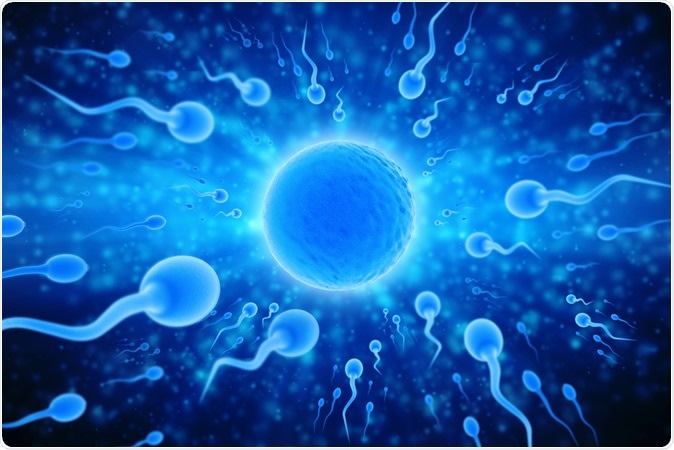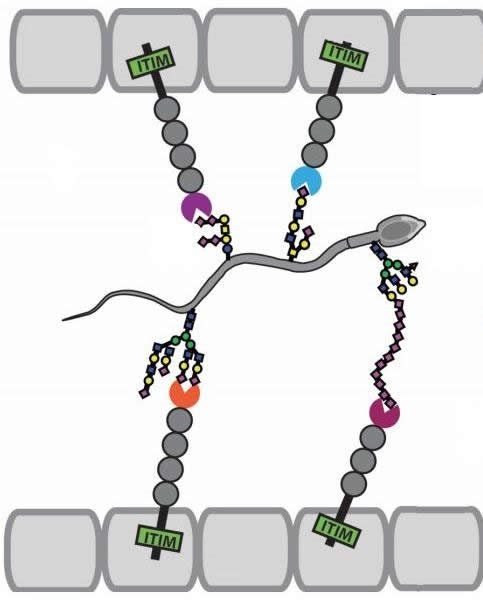Why does it take 200 million sperms to fertilize a single egg? The single sperm that reached the finished line has successfully survived multiple checkpoints within the female reproductive tract, dubbed as pre-fertilization events. Now, a new study shows that the uterus contains receptors that facilitate sperm survival.

Illustration Credit: Blackboard / Shutterstock
A team of researchers at the University of California, San Diego, found that the uterus contains multiple innate sialic acid-binding immunoglobulin-like lectins (Siglecs) that facilitate sperm survival upon entry in the uterus.
The study, which was published in the Journal of Biological Chemistry, show that one reasons why it takes millions of sperm cells to fertilize an egg is that when they arrive in the uters, they are bombarded by the immune system. The researchers believe that millions of sperm cells are needed so the one who’ll fertilize the egg will survive.
"I’m a lonely zoologist in a medical school. My elevator spiel is that all of life is one big compromise. For an egg, being too easy to fertilize is bad, being too difficult to fertilize is also bad,” Pascal Gagneux, lead author of the study, said.
Uterine receptor cells aid in sperm survival
In the study, however, they found the markings of a connection between the sperm and the cells that line the uterus. The cells in the uterus release a receptor that can detect a glycan molecule on the sperm’s surface. The researchers believe that perhaps the interaction may regulate the woman’s immune response, helping the sperm to make it through pre-fertilization events, such as the leukocytic reaction.

Before they reach the egg, sperm have to survive by the female immune system. An interaction between glycans (branched structures) on the surface of sperm and receptors on cells of the endometrium may act as a 'secret handshake,' helping sperm survive -- or it may help the immune system target faulty sperm. Credit: American Society for Biochemistry and Molecular Biology
The leukocytic response is a part of the pre-fertilization events that happen, wherein the sperm may stimulate an immune response. This promotes movement of circulating leukocytes to the uterus to kill or destroy most sperm cells.
The attack by the immune system destroys most of the sperm cells in semen, narrowing the number to just a few hundred that can enter the fallopian tubes. The response is the body’s way to prevent polyspermy, a condition wherein an egg is fertilized by more than one sperm.
Sialic acid binding receptors aids in sperm survival
However, glycoconjugates cover the sperm surface. These include sialic acids that are prominent at the sperm’s surface where they cap many glycan chains and control sperm movement through cervical mucus, sperm capacitation, and formation of sperm oviductal reservoir. Also, the immune system uses sialic acid to differentiate human cells from foreign invaders.
The researchers initially projected that the glycan might be involved in the interactions with neutrophils, but upon assessment, they found that neutrophils can’t distinguish sperms with or without sialic acid.
The researchers utilized in vitro interactions between the sperm and neutrophils, and at the same time, binding assays between sperm and recombinant Siglec-Fc chimeric proteins to quantify interactions.
Also, the researchers examined if sialic acid binding receptors, called siglecs are expressed on the uterus of humans or mice models, which can trigger the leukocytic reaction.
They also found that upon analysis of siglecs on endometrial cells, the endometrial receptors can bind with the whole sperm. The binding may aid the sperm in dampening the immune reaction. The uterus may also perform this to separate faulty sperms and at the same time, the immune system can recognize the sperm as “self”, hence, turning down inflammation. On the other hand, if it sees the sperm as an invader, it can turn up inflammation.
“Surprisingly less sialylated, capacitated, sperm did not increase neutrophil activation in vitro. However, we observed expression of several Siglecs on the endometrium and that these receptors interact with sialylated sperm,” the researchers wrote in the study.
“Our results indicate that sperm sialic acids may interact with endometrial Siglecs and that these interactions facilitate sperm survival in the face of female immunity,” they added.
The researchers encourage further studies on the area. It’s important to know more about the direct interaction between the sperm and uterine cells, aside from just looking at the sperm interacting with certain purified proteins.
They believe that the study can open the doors to further researches to work on a poorly understood area, especially that it’s about reproduction, which is a very delicate concept.
“The fact that there is (also) this immune game going on is completely fascinating,” Gagneux added.
Journal reference:
Eillen Tecle, Hector Sequoyah Reynoso, Ruixuan Wang and Pascal Gagneux, 'The female reproductive tract contains multiple innate sialic acid-binding immunoglobulin-like lectins (Siglecs) that facilitate sperm survival', doi: 10.1074/jbc.RA119.008729, http://www.jbc.org/content/early/2019/06/14/jbc.RA119.008729.abstract?sid=05f532e6-1ab8-4412-8491-2b605312130a